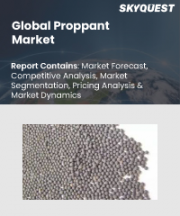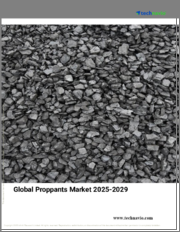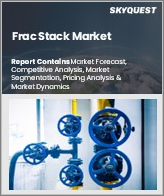
|
시장보고서
상품코드
1831996
자극 재료 시장 보고서 : 유형, 기술, 용도, 지역별(2025-2033년)Stimulation Materials Market Report by Type (Proppants, Chemical), Technology (Hydraulic Fracturing, Acidization), Application (Onshore, Offshore), and Region 2025-2033 |
||||||
세계의 자극 재료 시장 규모는 2024년 655억 달러에 달했습니다. 향후 IMARC Group은 시장이 2033년까지 1,466억 달러에 이르며, 2025년부터 2033년까지 9.4%의 성장률(CAGR)을 나타낼 것으로 예측했습니다.
자극 재료는 석유 및 가스정에서 미생물을 주입하고 왁스나 아스팔텐 등의 중질성분의 침전물을 제거하는데 사용됩니다. 일반적으로 코티드 샌드, 원시 플랙, 점토계 세라믹, 소결 보크사이트 등의 프로판트로 구성됩니다. 현재 선도적인 제조업체는 플럭스 높이, 주입 유체 및 갱도 청소의 필요성을 줄이는 초경량 프로판트를 도입하고 있습니다. 또한 자극과 석유 및 가스 흐름을 강화하기 위한 표준 및 맞춤형 화학 솔루션을 제공합니다. 이러한 솔루션에는 가교제, 차단기, 완충제, 점토 제어, 계면활성제, 살생물제, 마찰 감소제, 스케일 방지제, 겔화 시스템 등의 고급 통합 유체 시스템이 포함됩니다.
자극 재료 시장 동향 :
연료에 대한 요구 증가는 세계 셰일 가스의 사용에 긍정적인 영향을 미칩니다. 이것은 탄화수소 저류층에서 수압 파쇄에 의해 셰일 가스를 추출하기 위한 세계 자극 재료 수요에 영향을 미치는 주요 요인 중 하나입니다. 또한 많은 국가의 정부가 수압 파쇄의 악영향을 최소화하기 위해 엄격한 규제를 실시했습니다. 그 결과, 환경에 미치는 영향이 적은 녹색 재료의 채용이 촉진되고 있습니다. 이외에도 수평 드릴링, 대량 드릴링, 다단 드릴링 등의 수압 파쇄 기술의 발전이 셰일 자원 개발과 함께 드릴링 효율을 향상시키는 새로운 자극 재료 수요를 촉진하고 있습니다. 또한 세계적인 석유 및 가스 가격의 상승도 기업에 의한 자극 등의 선진적인 방법의 채용을 뒷받침하고 있습니다. 또한 주요 제조업체는 열안정성, 내약품성, 내파쇄성을 갖추어 심천의 석유 및 가스 파쇄시의 고온·폐색 응력 환경하에서의 프로판트의 역류를 방지하는 제품을 투입하고 있습니다. 또한 갱정의 생산성을 높이면서 물 사용량을 최소화하는 부가가치가 높은 코티드 샌드나 세라믹 프로판트도 제공합니다. 이러한 혁신은 시장 성장을 가속할 것으로 예측됩니다.
이 보고서에서 다루는 주요 질문
- 자극 재료 시장 규모는?
- 자극 재료 시장 전망은?
- 자극 재료 시장을 견인하는 주요 요인은?
- 세계의 자극 재료 시장 주요 기업은?
목차
제1장 서문
제2장 조사 범위와 조사 방법
- 조사의 목적
- 이해관계자
- 데이터 소스
- 1차 정보
- 2차 정보
- 시장 추정
- 상향식 접근
- 하향식 접근
- 조사 방법
제3장 주요 요약
제4장 서론
제5장 세계의 자극 재료 시장
- 시장 개요
- 시장 실적
- COVID-19 영향
- 시장 예측
제6장 시장 분석 : 유형별
- 프롭탄트
- 주요 부문
- 프랙 샌드
- 수지 코팅
- 세라믹
- 주요 부문
- 화학 제품
- 주요 부문
- 계면활성제
- 겔화제
- 마찰 감소제
- 분해제
- 가교제
- 부식 및 스케일 억제제
- 살생제
- 기타
- 주요 부문
제7장 시장 분석 : 기술별
- 수압 파쇄
- 주요 부문
- 다단계 파쇄
- 재파쇄
- 주요 부문
- 산처리
- 주요 부문
- 염산 세척
- 매트릭스 산 자극
- 산 파쇄
- 주요 부문
제8장 시장 분석 : 용도별
- 온쇼어
- 오프쇼어
제9장 시장 분석 : 지역별
- 북미
- 미국
- 캐나다
- 아시아태평양
- 중국
- 일본
- 인도
- 한국
- 호주
- 인도네시아
- 기타
- 유럽
- 독일
- 프랑스
- 영국
- 이탈리아
- 스페인
- 러시아
- 기타
- 라틴아메리카
- 브라질
- 멕시코
- 기타
- 중동 및 아프리카
제10장 SWOT 분석
제11장 밸류체인 분석
제12장 Porter's Five Forces 분석
제13장 가격 분석
제14장 경쟁 구도
- 시장 구조
- 주요 기업
- 주요 기업 프로파일
- Akzo Nobel NV
- Baker Hughes Company
- BASF SE
- Carbo Ceramics Inc.
- Chevron Phillips Chemical Company LLC
- DuPont de Nemours Inc.
- Halliburton Company
- Hexion Inc.
- Saint-Gobain SA
- Schlumberger Limited
- Solvay SA
The global stimulation materials market size reached USD 65.5 Billion in 2024. Looking forward, IMARC Group expects the market to reach USD 146.6 Billion by 2033, exhibiting a growth rate (CAGR) of 9.4% during 2025-2033.
Stimulation materials are used in oil and gas wells to inject microbes and remove deposits of heavy components, such as wax and asphaltene. They generally comprise proppants, including coated sand, raw frac, clay-based ceramic, and sintered bauxite. Nowadays, leading manufacturers are introducing ultra-lightweight proppants that reduce frac height, injected fluids, and the need for wellbore cleanouts. They are also offering standard and customized chemical solutions for enhancing the stimulation process and the flow of oil and gas. These solutions include advanced integrated fluid systems like crosslinkers, breakers, buffers, clay control, surfactants, biocides, friction reducers, scale inhibitors, and gelling systems.
Stimulation Materials Market Trends:
The increasing need for fuel is positively influencing the use of shale gas worldwide. This represents one of the major factors influencing the demand for stimulation materials worldwide for extracting shale gas via hydraulic fracking in hydrocarbon reservoirs. Moreover, governments of numerous countries are implementing stringent regulations to minimize the negative effects of hydraulic fracking. This, in turn, is promoting the adoption of green materials with less impact on the environment. Apart from this, advances in hydraulic fracturing technology, such as horizontal drilling, high-volume, and multistage, along with the development of shale resources, are driving the demand for new stimulation materials to improve drilling efficiencies. The rising oil and gas prices worldwide are also encouraging companies to adopt advanced methods like stimulation. Furthermore, key manufacturers are introducing products that provide thermal stability and chemical and crush resistance and prevent proppant flow back in high-temperature and closure stress environments during the fracturing of deep gas and oil wells. They are also offering value-added coated sand and ceramic proppants that minimize water usage while increasing well productivity. These innovations are projected to impel the growth of the market.
Key Market Segmentation:
Breakup by Type:
- Proppants
- Frac Sand
- Resin Coated
- Ceramic
- Chemical
- Surfactants
- Gelling Agents
- Friction Reducers
- Breakers
- Crosslinking Agents
- Corrosion and Scale Inhibitors
- Biocides
- Others
Breakup by Technology:
- Hydraulic Fracturing
- Multistage Fracturing
- Re-fracturing
- Acidization
- Hydrochloric Acid Wash
- Matrix Acid Stimulation
- Acid Fracturing
Breakup by Application:
- Onshore
- Offshore
Breakup by Region:
- North America
- United States
- Canada
- Asia-Pacific
- China
- Japan
- India
- South Korea
- Australia
- Indonesia
- Others
- Europe
- Germany
- France
- United Kingdom
- Italy
- Spain
- Russia
- Others
- Latin America
- Brazil
- Mexico
- Others
- Middle East and Africa
Competitive Landscape:
The competitive landscape of the industry has also been examined along with the profiles of the key players being Akzo Nobel N.V., Baker Hughes Company, BASF SE, Carbo Ceramics Inc., Chevron Phillips Chemical Company LLC, DuPont de Nemours Inc., Halliburton Company, Hexion Inc., Saint-Gobain S.A, Schlumberger Limited and Solvay S.A.
Key Questions Answered in This Report
- 1.How big is the stimulation materials market?
- 2.What is the future outlook of stimulation materials market?
- 3.What are the key factors driving the stimulation materials market?
- 4.Which are the leading companies in the global stimulation materials market?
Table of Contents
1 Preface
2 Scope and Methodology
- 2.1 Objectives of the Study
- 2.2 Stakeholders
- 2.3 Data Sources
- 2.3.1 Primary Sources
- 2.3.2 Secondary Sources
- 2.4 Market Estimation
- 2.4.1 Bottom-Up Approach
- 2.4.2 Top-Down Approach
- 2.5 Forecasting Methodology
3 Executive Summary
4 Introduction
- 4.1 Overview
- 4.2 Key Industry Trends
5 Global Stimulation Materials Market
- 5.1 Market Overview
- 5.2 Market Performance
- 5.3 Impact of COVID-19
- 5.4 Market Forecast
6 Market Breakup by Type
- 6.1 Proppants
- 6.1.1 Market Trends
- 6.1.2 Key Segments
- 6.1.2.1 Frac Sand
- 6.1.2.2 Resin Coated
- 6.1.2.3 Ceramic
- 6.1.3 Market Forecast
- 6.2 Chemical
- 6.2.1 Market Trends
- 6.2.2 Key Segments
- 6.2.2.1 Surfactants
- 6.2.2.2 Gelling Agents
- 6.2.2.3 Friction Reducers
- 6.2.2.4 Breakers
- 6.2.2.5 Crosslinking Agents
- 6.2.2.6 Corrosion and Scale Inhibitors
- 6.2.2.7 Biocides
- 6.2.2.8 Others
- 6.2.3 Market Forecast
7 Market Breakup by Technology
- 7.1 Hydraulic Fracturing
- 7.1.1 Market Trends
- 7.1.2 Key Segments
- 7.1.2.1 Multistage Fracturing
- 7.1.2.2 Re-fracturing
- 7.1.3 Market Forecast
- 7.2 Acidization
- 7.2.1 Market Trends
- 7.2.2 Key Segments
- 7.2.2.1 Hydrochloric Acid Wash
- 7.2.2.2 Matrix Acid Stimulation
- 7.2.2.3 Acid Fracturing
- 7.2.3 Market Forecast
8 Market Breakup by Application
- 8.1 Onshore
- 8.1.1 Market Trends
- 8.1.2 Market Forecast
- 8.2 Offshore
- 8.2.1 Market Trends
- 8.2.2 Market Forecast
9 Market Breakup by Region
- 9.1 North America
- 9.1.1 United States
- 9.1.1.1 Market Trends
- 9.1.1.2 Market Forecast
- 9.1.2 Canada
- 9.1.2.1 Market Trends
- 9.1.2.2 Market Forecast
- 9.1.1 United States
- 9.2 Asia-Pacific
- 9.2.1 China
- 9.2.1.1 Market Trends
- 9.2.1.2 Market Forecast
- 9.2.2 Japan
- 9.2.2.1 Market Trends
- 9.2.2.2 Market Forecast
- 9.2.3 India
- 9.2.3.1 Market Trends
- 9.2.3.2 Market Forecast
- 9.2.4 South Korea
- 9.2.4.1 Market Trends
- 9.2.4.2 Market Forecast
- 9.2.5 Australia
- 9.2.5.1 Market Trends
- 9.2.5.2 Market Forecast
- 9.2.6 Indonesia
- 9.2.6.1 Market Trends
- 9.2.6.2 Market Forecast
- 9.2.7 Others
- 9.2.7.1 Market Trends
- 9.2.7.2 Market Forecast
- 9.2.1 China
- 9.3 Europe
- 9.3.1 Germany
- 9.3.1.1 Market Trends
- 9.3.1.2 Market Forecast
- 9.3.2 France
- 9.3.2.1 Market Trends
- 9.3.2.2 Market Forecast
- 9.3.3 United Kingdom
- 9.3.3.1 Market Trends
- 9.3.3.2 Market Forecast
- 9.3.4 Italy
- 9.3.4.1 Market Trends
- 9.3.4.2 Market Forecast
- 9.3.5 Spain
- 9.3.5.1 Market Trends
- 9.3.5.2 Market Forecast
- 9.3.6 Russia
- 9.3.6.1 Market Trends
- 9.3.6.2 Market Forecast
- 9.3.7 Others
- 9.3.7.1 Market Trends
- 9.3.7.2 Market Forecast
- 9.3.1 Germany
- 9.4 Latin America
- 9.4.1 Brazil
- 9.4.1.1 Market Trends
- 9.4.1.2 Market Forecast
- 9.4.2 Mexico
- 9.4.2.1 Market Trends
- 9.4.2.2 Market Forecast
- 9.4.3 Others
- 9.4.3.1 Market Trends
- 9.4.3.2 Market Forecast
- 9.4.1 Brazil
- 9.5 Middle East and Africa
- 9.5.1 Market Trends
- 9.5.2 Market Breakup by Country
- 9.5.3 Market Forecast
10 SWOT Analysis
- 10.1 Overview
- 10.2 Strengths
- 10.3 Weaknesses
- 10.4 Opportunities
- 10.5 Threats
11 Value Chain Analysis
12 Porters Five Forces Analysis
- 12.1 Overview
- 12.2 Bargaining Power of Buyers
- 12.3 Bargaining Power of Suppliers
- 12.4 Degree of Competition
- 12.5 Threat of New Entrants
- 12.6 Threat of Substitutes
13 Price Analysis
14 Competitive Landscape
- 14.1 Market Structure
- 14.2 Key Players
- 14.3 Profiles of Key Players
- 14.3.1 Akzo Nobel N.V.
- 14.3.1.1 Company Overview
- 14.3.1.2 Product Portfolio
- 14.3.1.3 Financials
- 14.3.1.4 SWOT Analysis
- 14.3.2 Baker Hughes Company
- 14.3.2.1 Company Overview
- 14.3.2.2 Product Portfolio
- 14.3.2.3 Financials
- 14.3.2.4 SWOT Analysis
- 14.3.3 BASF SE
- 14.3.3.1 Company Overview
- 14.3.3.2 Product Portfolio
- 14.3.3.3 Financials
- 14.3.3.4 SWOT Analysis
- 14.3.4 Carbo Ceramics Inc.
- 14.3.4.1 Company Overview
- 14.3.4.2 Product Portfolio
- 14.3.4.3 SWOT Analysis
- 14.3.5 Chevron Phillips Chemical Company LLC
- 14.3.5.1 Company Overview
- 14.3.5.2 Product Portfolio
- 14.3.5.3 SWOT Analysis
- 14.3.6 DuPont de Nemours Inc.
- 14.3.6.1 Company Overview
- 14.3.6.2 Product Portfolio
- 14.3.6.3 Financials
- 14.3.6.4 SWOT Analysis
- 14.3.7 Halliburton Company
- 14.3.7.1 Company Overview
- 14.3.7.2 Product Portfolio
- 14.3.7.3 Financials
- 14.3.7.4 SWOT Analysis
- 14.3.8 Hexion Inc.
- 14.3.8.1 Company Overview
- 14.3.8.2 Product Portfolio
- 14.3.9 Saint-Gobain S.A
- 14.3.9.1 Company Overview
- 14.3.9.2 Product Portfolio
- 14.3.9.3 Financials
- 14.3.9.4 SWOT Analysis
- 14.3.10 Schlumberger Limited
- 14.3.10.1 Company Overview
- 14.3.10.2 Product Portfolio
- 14.3.10.3 Financials
- 14.3.10.4 SWOT Analysis
- 14.3.11 Solvay S.A
- 14.3.11.1 Company Overview
- 14.3.11.2 Product Portfolio
- 14.3.11.3 Financials
- 14.3.11.4 SWOT Analysis
- 14.3.1 Akzo Nobel N.V.




















